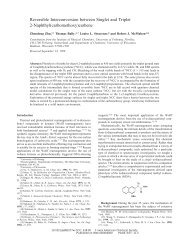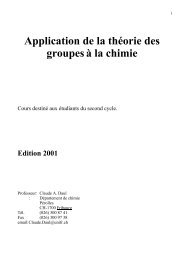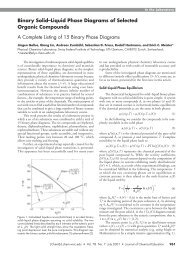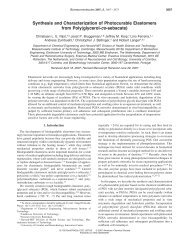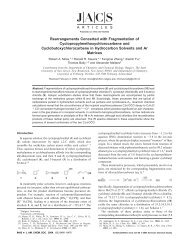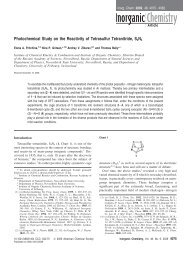Ultrafast Spectroscopic and Matrix Isolation Studies of p-Biphenylyl ...
Ultrafast Spectroscopic and Matrix Isolation Studies of p-Biphenylyl ...
Ultrafast Spectroscopic and Matrix Isolation Studies of p-Biphenylyl ...
Create successful ePaper yourself
Turn your PDF publications into a flip-book with our unique Google optimized e-Paper software.
<strong>Ultrafast</strong> Spectroscopy <strong>of</strong> Arylnitrenium Cations ARTICLES<br />
Figure 9. (a) IR spectrum <strong>of</strong> 17 calculated by B3LYP/6-31G*; (b) IR<br />
spectrum produced by bleaching <strong>of</strong> 1-naphthyl azide 14 in Ar/HCl<br />
at 254 nm (negative peaks) <strong>and</strong> formation <strong>of</strong> the nitrenium cation 17<br />
(positive peaks); (c) bleaching <strong>of</strong> 17 (negative peaks) by irradiation at λ ><br />
475 nm.<br />
LUMO maintains an essentially nonbonding character, favoring<br />
excitations from filled orbitals to the LUMO (Supporting<br />
Information, Figure S11).<br />
In Figure 9, the calculated IR spectrum <strong>of</strong> 1-naphthylnitrenium<br />
cation (spectrum a) is correlated with a series <strong>of</strong> b<strong>and</strong>s<br />
which are generated by the initial photolysis at 254 nm <strong>of</strong> 14<br />
in an Ar matrix containing 30% HCl (spectrum b) <strong>and</strong> bleached<br />
by the second irradiation (λ > 475 nm, spectrum c). The<br />
agreement with experiment (dashed lines in Figure 9) is<br />
satisfactory <strong>and</strong> seems to leave little doubt about the identity<br />
<strong>of</strong> the species obtained. However, the identity <strong>of</strong> the species<br />
formed upon bleaching is again not revealed by the IR<br />
spectrum which shows interesting unassigned b<strong>and</strong>s at 1600-<br />
1700 cm -1 .<br />
Nevertheless we note some disagreement between the experimental<br />
spectra, in particular in the case <strong>of</strong> the naphthylnitrenium<br />
cation 17 where some major experimental b<strong>and</strong>s,<br />
e.g., the pair between 1620 <strong>and</strong> 1700 cm -1 , are not predicted<br />
to occur. We believe that this may be due to (a) photoprotonation<br />
<strong>of</strong> 15 at the aromatic ring, rather than at the N-atom, or (b)<br />
attachment <strong>of</strong> the chloride anion to the aromatic ring, as was<br />
found to occur in nitrenium cations obtained by photolysis <strong>of</strong><br />
aminopyridinium cations. 24 We are currently exploring these<br />
possibilities.<br />
3. Experimental Section<br />
3.1. Synthesis. The syntheses <strong>of</strong> the azides used in this work have<br />
been previously reported. 1-4,37,45<br />
3.2. <strong>Matrix</strong> <strong>Isolation</strong> Spectroscopy. 35 A few ground crystals <strong>of</strong><br />
azides were placed in a U-tube attached to the inlet system <strong>of</strong> a closedcycle<br />
cryostat. A mixture <strong>of</strong> argon (Carbagas, 99.995%) with 10%<br />
nitrogen (Carbagas, 99.995%) was flowed through the U-tube <strong>and</strong><br />
slowly deposited on a CsI window (UV transparent quality, Korth<br />
Kristalle GmbH) maintained at ca. 20 K. In the protonation<br />
experiments, 30% dry gaseous HCl was added to the mixture. During<br />
deposition the temperature <strong>of</strong> the U-tube was kept at 14 °C for<br />
p-biphenylyl azide, 19 °C for o-biphenylyl azide, <strong>and</strong> -27 °C for<br />
1-naphthyl azide. Photolysis <strong>of</strong> the azides was performed with a<br />
low-pressure Hg lamp, whereas for the bleaching <strong>of</strong> the nitrenium<br />
cations a high-pressure Hg/Xe arc was used with 590 nm or 475 nm<br />
cut<strong>of</strong>f filters (cf., captions <strong>of</strong> figures). Electronic absorption spectra<br />
were recorded on a Perkin-Elmer Lambda 900 spectrometer<br />
(200-1000 nm). IR spectra were measured on a Bomem DA3<br />
interferometer (4000-500 cm -1 ) with a mercury cadmium telluride<br />
(MCT) detector.<br />
3.3. Computational Chemistry. The geometries <strong>and</strong> harmonic<br />
vibrational frequencies <strong>of</strong> the three nitrenium cations (6, 11, <strong>and</strong> 17)<br />
were calculated by the B3LYP density functional method 46,47<br />
using the 6-31G(d) basis set, with the Gaussian 03 suite <strong>of</strong> programs. 48<br />
All equilibrium structures were ascertained to be minima on the<br />
potential energy surfaces. The harmonic frequencies were scaled<br />
by a factor <strong>of</strong> 0.96 for their use in assigning the experimental IR<br />
spectra. 49<br />
Excited-state energies <strong>of</strong> the nitrenium cations were calculated at<br />
the above geometries by the CASSCF/CASPT2 procedure 50,51 with the<br />
ANO-S basis set <strong>of</strong> Pierloot et al. 52 using the MOLCAS program. 53 In<br />
order to arrive at a satisfactory description <strong>of</strong> all excited states at the<br />
CASPT2 level (i.e., remove intruder states) it was necessary to resort<br />
to the level-shifting technique, 54 whereby it was carefully ascertained<br />
that no artifacts are introduced.<br />
3.4. <strong>Ultrafast</strong> Spectroscopy. Details <strong>of</strong> the ultrafast time-resolved<br />
spectrometer in use at The Ohio State University Center for Chemical<br />
<strong>and</strong> Biophysical Dynamics have been reported elsewhere. 29<br />
4. Conclusions<br />
The lifetimes <strong>of</strong> certain singlet arylnitrenes at ambient<br />
temperature are too short to allow for their protonation to form<br />
the corresponding nitrenium cations on the nanosecond time<br />
scale. We have shown using ultrafast time-resolved flash<br />
photolysis methods that two such nitrenium cations can be<br />
conveniently generated from p- <strong>and</strong> o-biphenylyl <strong>and</strong> 1-naphthyl<br />
azides in 88% formic acid. In this solvent, o-biphenylyl (τ )<br />
7.7 ps) <strong>and</strong> 1-naphthylnitrene (τ ) 8.4 ps) are protonated <strong>and</strong><br />
converted to nitrenium cations. In many respects, 88% aqueous<br />
formic acid is the ideal solvent for direct detection <strong>of</strong> monosubstituted<br />
arylnitrenium cations. The azide precursors<br />
dissolve readily <strong>and</strong> have sufficient stability in this solvent for<br />
photochemical studies, <strong>and</strong> the corresponding nitrenes are<br />
readily protonated, <strong>and</strong> the resultant nitrenium ions have<br />
relatively long lifetimes in this solvent. These experiments show<br />
also that the singlet nitrenes, rather than the excited states <strong>of</strong><br />
the azides, are the direct precursors <strong>of</strong> the nitrenium cations as<br />
first proposed by McClell<strong>and</strong> et al. 4 These same nitrenes can<br />
be protonated in argon/HCl matrices to form persistent nitrenium<br />
cations which can be characterized by both electronic <strong>and</strong><br />
vibrational spectroscopy <strong>and</strong> whose spectra are in excellent<br />
agreement with the predictions <strong>of</strong> theory. These two approaches<br />
(46) Lee, C.; Yang, W.; Parr, R. G. Phys. ReV. B: Condens. Matter 1988, 37,<br />
785-789.<br />
(47) Becke, A. D. J. Chem. Phys. 1993, 98, 5648-5652.<br />
(48) Frisch, M. J.; et al. Gaussian 03, revision C.01; Gaussian, Inc.: Wallingford,<br />
CT, 2005.<br />
(49) Scott, A. P.; Radom, L. J. Phys. Chem. 1996, 100, 16502-16513.<br />
(50) Roos, B. AdV. Chem. Phys. 1987, 69, 399-445.<br />
(51) Andersson, K.; Roos, B. O. In AdVanced Series in Physical Chemistry;<br />
1995; Vol. 2, pp 55-109.<br />
(52) Pierloot, K.; Dumez, B.; Widmark, P.-O.; Roos, B. O. Theor. Chim. Acta<br />
1995, 90, 87-114.<br />
(53) Andersson, K.; Blomberg, M. R. A.; Fülscher, M. P.; Kellö, V.; Lindh, R.;<br />
Malmqvist, P.-Å.; Noga, J.; Olson, J.; Roos, B. O.; Sadlej, A.; Siegbahn,<br />
P. E. M.; Urban, M.; Widmark, P.-O. MOLCAS, version 5. University <strong>of</strong><br />
Lund, 2002.<br />
(54) Roos, B. O.; Andersson, K.; Fuelscher, M. P.; Serrano-Andres, L.; Pierloot,<br />
K.; Merchan, M.; Molina, V. THEOCHEM 1996, 388, 257-276.<br />
J. AM. CHEM. SOC. 9 VOL. 129, NO. 26, 2007 8387




